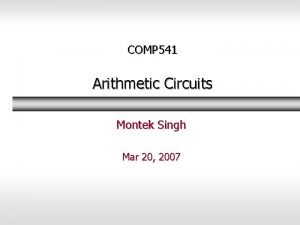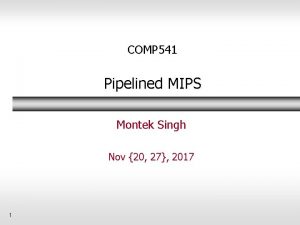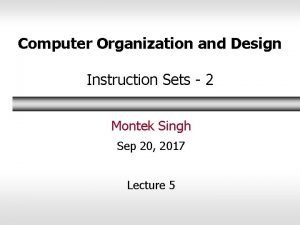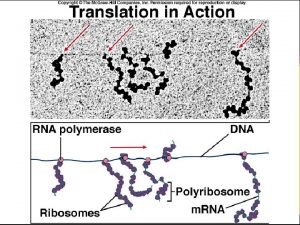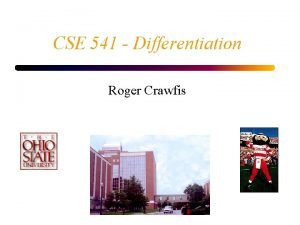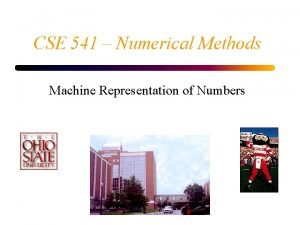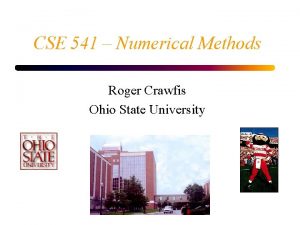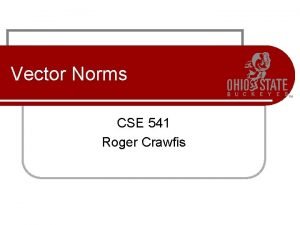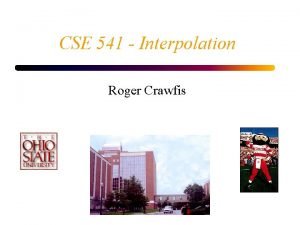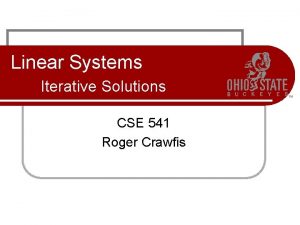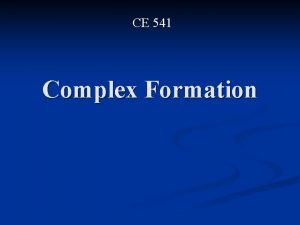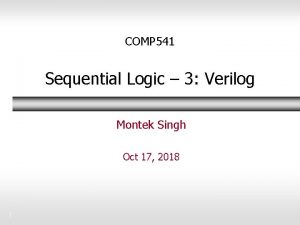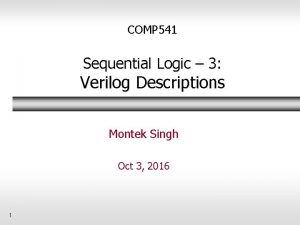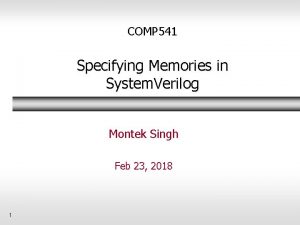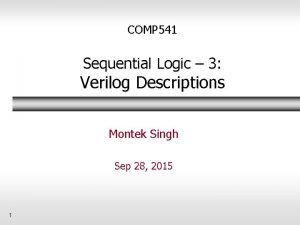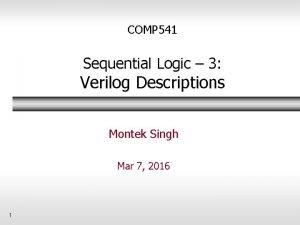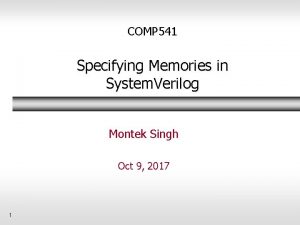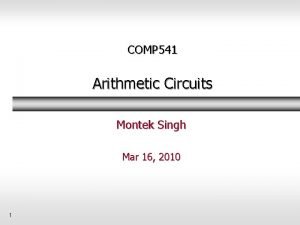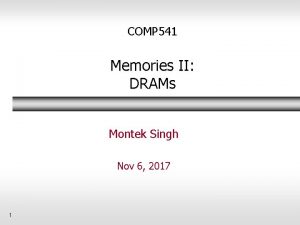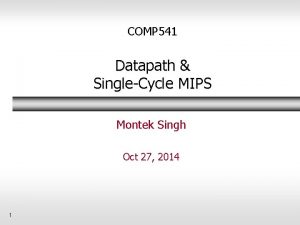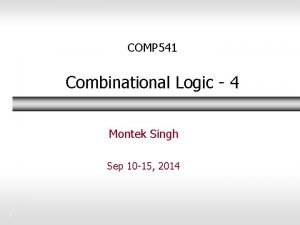COMP 541 Verilog Primer Montek Singh Aug 28









![ME module me(E, Ei); input [3: 0] Ei; output E; assign E = ~(Ei[0] ME module me(E, Ei); input [3: 0] Ei; output E; assign E = ~(Ei[0]](https://slidetodoc.com/presentation_image_h2/ce327d636d9463e6ad1eb882d3aac6b0/image-10.jpg)
![Top Level module top(A, B, E); input [3: 0] A; input [3: 0] B; Top Level module top(A, B, E); input [3: 0] A; input [3: 0] B;](https://slidetodoc.com/presentation_image_h2/ce327d636d9463e6ad1eb882d3aac6b0/image-11.jpg)


![Constants in Verilog ã Syntax [size][’radix]constant ã ã Radix can be d, b, h, Constants in Verilog ã Syntax [size][’radix]constant ã ã Radix can be d, b, h,](https://slidetodoc.com/presentation_image_h2/ce327d636d9463e6ad1eb882d3aac6b0/image-14.jpg)
![Vector of Wires (Bus) ã Denotes a set of wires input [1: 0] S; Vector of Wires (Bus) ã Denotes a set of wires input [1: 0] S;](https://slidetodoc.com/presentation_image_h2/ce327d636d9463e6ad1eb882d3aac6b0/image-15.jpg)

![4 -to-1 Mux Truth Table-ish module mux_4_to_1_dataflow( input [1: 0] S, input [3: 0] 4 -to-1 Mux Truth Table-ish module mux_4_to_1_dataflow( input [1: 0] S, input [3: 0]](https://slidetodoc.com/presentation_image_h2/ce327d636d9463e6ad1eb882d3aac6b0/image-17.jpg)
![Verilog for Decision Tree module mux_4_to_1_binary_decision( input [1: 0] S, input [3: 0] D, Verilog for Decision Tree module mux_4_to_1_binary_decision( input [1: 0] S, input [3: 0] D,](https://slidetodoc.com/presentation_image_h2/ce327d636d9463e6ad1eb882d3aac6b0/image-18.jpg)
![Binary Decisions ã If S[1] == 1, branch one way assign Y = S[1] Binary Decisions ã If S[1] == 1, branch one way assign Y = S[1]](https://slidetodoc.com/presentation_image_h2/ce327d636d9463e6ad1eb882d3aac6b0/image-19.jpg)



![Bitwise Operators (we have used) NOTE: The [3: 0] range module gates(input [3: 0] Bitwise Operators (we have used) NOTE: The [3: 0] range module gates(input [3: 0]](https://slidetodoc.com/presentation_image_h2/ce327d636d9463e6ad1eb882d3aac6b0/image-23.jpg)





![Bit Manipulations: splitting bits off Verilog: module mux 2_8(input [7: 0] d 0, d Bit Manipulations: splitting bits off Verilog: module mux 2_8(input [7: 0] d 0, d](https://slidetodoc.com/presentation_image_h2/ce327d636d9463e6ad1eb882d3aac6b0/image-29.jpg)
![Bit Manipulations: packing bits assign y = {a[2: 1], {3{b[0]}}, a[0], 6’b 100_010}; // Bit Manipulations: packing bits assign y = {a[2: 1], {3{b[0]}}, a[0], 6’b 100_010}; //](https://slidetodoc.com/presentation_image_h2/ce327d636d9463e6ad1eb882d3aac6b0/image-30.jpg)

















- Slides: 47

COMP 541 Verilog Primer Montek Singh Aug 28, 2015 (draft version to be updated) 1

Topics ã Hierarchical Design ã Verilog Primer l basic constructs l hierarchical design l combinational logic l sequential logic will be covered later 2

Design Hierarchy ã Just like with large program, to design a large chip need hierarchy ã Divide and Conquer l To create, test, and also to understand ã Block in a block diagram is equivalent to l object in a programming language l module in Verilog 3

Hierarchy ã Always make your design modular l easier to read and debug l easier to reuse ã Before you write even one line of Verilog… l …draw a picture Ø black boxes Ø boxes within boxes … 4

Hierarchy Example: 4 -bit Equality ã Input: 2 vectors A(3: 0) and B(3: 0) ã Output: One bit, E, which is 1 if A and B are bitwise equal, 0 otherwise 5

Hierarchy Example: 4 -bit Equality ã Hierarchical design seems a good approach ã One module/bit ã Final module for E 6

Design for MX module ã Logic function is l It is actually “not Equal” l Can implement as 7

Design for ME module ã Final E is 1 only if all intermediate values are 0 ã So ã And a design is 8

MX module mx(A, B, E); input A, B; output E; assign E = (~A & B) | (A & ~B); endmodule 9
![ME module meE Ei input 3 0 Ei output E assign E Ei0 ME module me(E, Ei); input [3: 0] Ei; output E; assign E = ~(Ei[0]](https://slidetodoc.com/presentation_image_h2/ce327d636d9463e6ad1eb882d3aac6b0/image-10.jpg)
ME module me(E, Ei); input [3: 0] Ei; output E; assign E = ~(Ei[0] | Ei[1] | Ei[2] | Ei[3]); endmodule 10
![Top Level module topA B E input 3 0 A input 3 0 B Top Level module top(A, B, E); input [3: 0] A; input [3: 0] B;](https://slidetodoc.com/presentation_image_h2/ce327d636d9463e6ad1eb882d3aac6b0/image-11.jpg)
Top Level module top(A, B, E); input [3: 0] A; input [3: 0] B; output E; wire [3: 0] Ei; mx mx m 0(A[0], m 1(A[1], m 2(A[2], m 3(A[3], B[0], B[1], B[2], B[3], Ei[0]); Ei[1]); Ei[2]); Ei[3]); me me 0(E, Ei); endmodule 11

More on Verilog A tutorial 12

Change Topics to ã Verilog l Basic syntax and structure ã Verilog test programs 13
![Constants in Verilog ã Syntax sizeradixconstant ã ã Radix can be d b h Constants in Verilog ã Syntax [size][’radix]constant ã ã Radix can be d, b, h,](https://slidetodoc.com/presentation_image_h2/ce327d636d9463e6ad1eb882d3aac6b0/image-14.jpg)
Constants in Verilog ã Syntax [size][’radix]constant ã ã Radix can be d, b, h, or o (default d) Examples: assign assign Y Y Y = = = 10; // Decimal 10 ’b 10; // Binary 10, decimal 2 ’h 10; // Hex 10, decimal 16 8’b 0100_0011 // Underline ignored 8’b 0100_0011 // space ignored ã Binary values can be 0, 1 (or x or z) 14
![Vector of Wires Bus ã Denotes a set of wires input 1 0 S Vector of Wires (Bus) ã Denotes a set of wires input [1: 0] S;](https://slidetodoc.com/presentation_image_h2/ce327d636d9463e6ad1eb882d3aac6b0/image-15.jpg)
Vector of Wires (Bus) ã Denotes a set of wires input [1: 0] S; ã Syntax is [a : b] l So this could be “[0: 1] S” l Order will matter when we make assignments with values bigger than one bit l Or when we connect sets of wires l Stick to the same ordering throughout design ã NOTE: THIS IS NOT AN ARRAY! 15

Conditional Assignment ã Equality test S == 2’b 00 ã Assignment assign Y = (S == 2’b 00)? 1’b 0: 1’b 1; l If true, assign 0 to Y l If false, assign 1 to Y 16
![4 to1 Mux Truth Tableish module mux4to1dataflow input 1 0 S input 3 0 4 -to-1 Mux Truth Table-ish module mux_4_to_1_dataflow( input [1: 0] S, input [3: 0]](https://slidetodoc.com/presentation_image_h2/ce327d636d9463e6ad1eb882d3aac6b0/image-17.jpg)
4 -to-1 Mux Truth Table-ish module mux_4_to_1_dataflow( input [1: 0] S, input [3: 0] D, output Y ); assign Y = (S (S endmodule == == 2'b 00) 2'b 01) 2'b 10) 2'b 11) ? ? D[0] D[1] D[2] D[3] : : 1'bx ; 17
![Verilog for Decision Tree module mux4to1binarydecision input 1 0 S input 3 0 D Verilog for Decision Tree module mux_4_to_1_binary_decision( input [1: 0] S, input [3: 0] D,](https://slidetodoc.com/presentation_image_h2/ce327d636d9463e6ad1eb882d3aac6b0/image-18.jpg)
Verilog for Decision Tree module mux_4_to_1_binary_decision( input [1: 0] S, input [3: 0] D, output Y ); assign Y = S[1] ? (S[0] ? D[3] : D[2]) : (S[0] ? D[1] : D[0]) ; endmodule 18
![Binary Decisions ã If S1 1 branch one way assign Y S1 Binary Decisions ã If S[1] == 1, branch one way assign Y = S[1]](https://slidetodoc.com/presentation_image_h2/ce327d636d9463e6ad1eb882d3aac6b0/image-19.jpg)
Binary Decisions ã If S[1] == 1, branch one way assign Y = S[1] ? (S[0] ? D[3] : D[2]) l and decide Y = either D[2] or D[3] based on S[0] ã Else : (S[0] ? D[1] : D[0]) ; l decide Y is either D[2] or D[3] based on S[0] ã Notice that conditional test is for ‘ 1’ condition like C 19

Instance Port Names ã Module modp(output C, input A); ã Ports referenced as modp i_name(con. C, con. A) ã Also as modp i_name(. A(con. A), . C(con. C)); 20

Parameter ã Used to define constants parameter SIZE = 16; ã Or, for parameters local to a module: localparam SIZE = 16; ã More on these later 21

Internal Variables ã Internals = those that are not inputs/outputs l declare them as wire or reg in Verilog Ø depending on whether they are combinational or state holding l BETTER: declare them as just logic in System. Verilog Ø will cover later next week module fulladder(input a, b, cin, output s, cout); wire p, g; // internal assign p = a ^ b; assign g = a & b; assign s = p ^ cin; assign cout = g | (p & cin); endmodule
![Bitwise Operators we have used NOTE The 3 0 range module gatesinput 3 0 Bitwise Operators (we have used) NOTE: The [3: 0] range module gates(input [3: 0]](https://slidetodoc.com/presentation_image_h2/ce327d636d9463e6ad1eb882d3aac6b0/image-23.jpg)
Bitwise Operators (we have used) NOTE: The [3: 0] range module gates(input [3: 0] a, b, applies to both a and b output [3: 0] y 1, y 2, y 3, y 4, y 5); Similarly for all the outputs assign assign endmodule y 1 y 2 y 3 y 4 y 5 = = = a & a | a ^ ~(a b; b; b; & b); | b); // // // AND OR XOR NAND NOR

Comments // /*…*/ single line comment multiline comment

Reduction Operators (&) ã Unary operator that works on all of the bits l E. g. , AND all of the bits of a word together l Gives a 1 -bit result module and 8(input [7: 0] a, output y); assign y = &a; // &a is much easier to write than // assign y = a[7] & a[6] & a[5] & a[4] & // a[3] & a[2] & a[1] & a[0]; endmodule

Reduction Operators (|, ~&, ^, ~^, ^~) ã Several others (see online reference) l | = OR all the bits together l ~| = NOR all the bits together l ~& = NAND all the bits together l ^ = XOR all the bits together l ~^, ^~ = XNOR all the bits together

Operator Precedence Highest ~ NOT *, /, % mult, div, mod +, - add, sub <<, >> shift <<<, >>> arithmetic shift <, <=, >, >= comparison Lowest ==, != equal, not equal &, ~& AND, NAND ^, ~^ XOR, XNOR |, ~| OR, XOR ? : ternary operator

Numbers ã Format: N’Bvalue l N = number of bits, B = base l N’B is optional but recommended (default is decimal ) l whenever in doubt, specify the # of bits Number # Bits Base Decimal Equivalent Value Stored 3’b 101 3 binary 5 101 ’b 11 unsized binary 3 00… 0011 8’b 11 8 binary 3 00000011 8’b 1010_1011 8 binary 171 10101011 3’d 6 3 decimal 6 110 6’o 42 6 octal 34 100010 8’h. AB 8 hexadecimal 171 10101011 42 Unsized decimal 42 00… 0101010
![Bit Manipulations splitting bits off Verilog module mux 28input 7 0 d 0 d Bit Manipulations: splitting bits off Verilog: module mux 2_8(input [7: 0] d 0, d](https://slidetodoc.com/presentation_image_h2/ce327d636d9463e6ad1eb882d3aac6b0/image-29.jpg)
Bit Manipulations: splitting bits off Verilog: module mux 2_8(input [7: 0] d 0, d 1, input s, output [7: 0] y); mux 2 lsbmux(d 0[3: 0], d 1[3: 0], s, y[3: 0]); mux 2 msbmux(d 0[7: 4], d 1[7: 4], s, y[7: 4]); endmodule Synthesis:
![Bit Manipulations packing bits assign y a2 1 3b0 a0 6b 100010 Bit Manipulations: packing bits assign y = {a[2: 1], {3{b[0]}}, a[0], 6’b 100_010}; //](https://slidetodoc.com/presentation_image_h2/ce327d636d9463e6ad1eb882d3aac6b0/image-30.jpg)
Bit Manipulations: packing bits assign y = {a[2: 1], {3{b[0]}}, a[0], 6’b 100_010}; // if y is a 12 -bit signal, the above statement produces: y = a[2] a[1] b[0] a[0] 1 0 0 0 1 0 // underscores (_) are used formatting only to make it easier to read. Verilog ignores them.

Verilog for Simulation and Testing 31

Verilog for Simulation vs. Synthesis ã Simulation l you describe the circuit in Verilog l simulate it l good for Ø testing whether your conceptual design works before your spend $$ getting it fabricated in silicon ã Synthesis l you describe the behavior in Verilog l use a compiler to “compile” it into a circuit l good for Ø describing large-scale complex systems without every manually building them Ø the “compiler” translates it into a circuit for you! 32

Verilog for Simulation vs. Synthesis ã Remember: l for simulation: Verilog provides many more language constructs and features l for synthesis: Verilog supports only a subset of the language that makes sense! Ø called “synthesizable subset” 33

Test fixtures ã Testing your circuit using a Verilog test fixture Stimulus: ã Module module lab 1_part 1( ã Ports referenced as lab 1_part 1 uut(X, Y, Z, T) ã Also as lab 1_part 1 uut(. A(X), . B(Y), . Sum(T), . Cin(Z)) inputs input A, B, Cin, output Sum); outputs initial begin … end Circuit to be tested (“uut”) 34

Module and Instance UUT module syn_adder_for_example_v_tf(); // DATE: 21: 22: 20 01/25/2004 //. . . Bunch of comments. . . // Instantiate the UUT syn_adder uut (. B(B), . A(A), . C 0(C 0), . S(S), . C 4(C 4) ); . . . endmodule 35

Reg ã It will create storage for the inputs to the UUT // Inputs reg [3: 0] B; reg [3: 0] A; reg C 0; ã The keyword reg means “register” l Usually implies a storage element is created Ø Sometimes may be “optimized away” to create combinational logic ã We will use something else!! l System. Verilog has the logic type much better! 36

Wires for Outputs ã Specify bus size (for multibit wires) // Outputs wire [3: 0] S; wire C 4; 37

Begin/End ã Verilog uses begin and end for block l instead of curly braces 38

Initial ã Initial statement runs when simulation begins initial begin B = 0; A = 0; C 0 = 0; end ã Initial block is inherently sequential! l assignments inside initial happen one after the other 39

Procedural assignment ã Why no “assign”? l Because it is not a continuous assignment l It is a one-off assignment! l And here we use blocking assignments Ø So everything happens in sequence rather than in parallel – Good for describing test fixtures, but not good for synthesis! 40

What to put in the tester? ã Need to make simulation time pass ã Use # command for skipping time l time increases by 5 units when you encounter #5 ã Example (note no semicolon after #50) initial begin B = 0; #10; #50 B = 1; end 41

For ã Can use for loop in initial statement block initial begin for(i=0; i < 5; i = i + 1) begin #50 B = i; end 42

Integers ã Can declare for loop control variables l Will not synthesize, as far as I know integer i; integer j; ã Can copy to input regs l Be careful with signed vs. unsigned quantities 43

There also ã While ã Repeat ã Forever 44

Timescale ã Need to tell simulator what time scale to use ã Place at top of test fixture `timescale 1 ns/10 ps l the first number (1 ns) is the unit for time l the second number (10 ps) is the precision at which time is maintained (e. g. , 5. 01 ns) 45

System Tasks ã Tasks for the simulator ã $stop – end the simulation ã $display – like C printf ã $monitor – prints automatically when arguments change (example next) ã $time – Provides value of simulated time 46

Monitor // set up monitoring initial begin $monitor(“At time %d: A=%b , B=%bn", $time, A, B); end // These statements conduct the actual test initial begin Code. . . end 47
 Comp 541
Comp 541 Comp 541
Comp 541 Comp541
Comp541 Comp 541
Comp 541 Unc comp 541
Unc comp 541 Sarwan singh kundan singh
Sarwan singh kundan singh Arti montek
Arti montek 9 bit
9 bit Montek x 1000
Montek x 1000 Kaugnayan sa kaligirang pangkasaysayan ng el filibusterismo
Kaugnayan sa kaligirang pangkasaysayan ng el filibusterismo Words with amo root
Words with amo root Aug q
Aug q Translation
Translation Transkripsjon og translasjon
Transkripsjon og translasjon Aug comm device
Aug comm device Rna codon chart
Rna codon chart Cse 541
Cse 541 Cse 541
Cse 541 29 cfr part 541
29 cfr part 541 Cse 541
Cse 541 Norm van een vector
Norm van een vector Cse 541
Cse 541 Cse 541
Cse 541 Cs 541
Cs 541 541 ce
541 ce Recruitment motto
Recruitment motto Raj singh ucr
Raj singh ucr Gursharan singh tatla
Gursharan singh tatla Yogendra singh sociology
Yogendra singh sociology Dr gayatri singh
Dr gayatri singh Thorlabs austin
Thorlabs austin Nimi singh
Nimi singh Vasu renganathan
Vasu renganathan Prateek singh game
Prateek singh game Guru gobind singh study circle
Guru gobind singh study circle Warm chain in pediatrics
Warm chain in pediatrics Aorldw
Aorldw Manvinder singh jsa
Manvinder singh jsa Lessons from rocket singh movie
Lessons from rocket singh movie Left gonadal vein
Left gonadal vein Dr mayank singh
Dr mayank singh Tomb of jhangir
Tomb of jhangir Mannu singh vs umadat pandey
Mannu singh vs umadat pandey Summerpal singh gill
Summerpal singh gill Sexual harrasment prevention training
Sexual harrasment prevention training Hypertensive emergency definition
Hypertensive emergency definition Linux operating system presentation
Linux operating system presentation The mudaliar committee was appointed in
The mudaliar committee was appointed in

